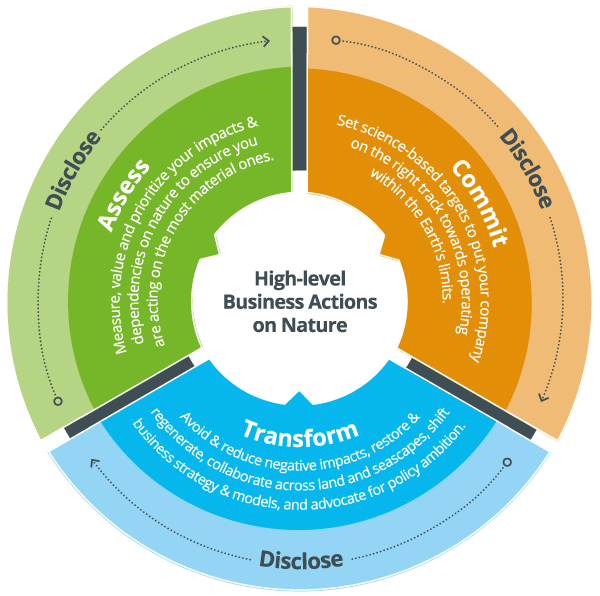Business for Nature, along with the Science Based Targets Network (SBTN) and several other partners, provides a framework called High-Level Business Action on Nature (see Figure 1). The framework offers an overview of key actions companies can take to help reverse nature loss and contribute to a nature positive world under the headings of Assess, Commit, Transform, and Disclose. Any claims companies make regarding their nature positive contributions will, at a minimum, need to be verifiable, consistent with the best available science, logically coherent, and in accordance with policy at a local and national level. This Advisor explores the framework’s actions.

Assess
- Measure and prioritize actions that will contribute most significantly to a nature positive world by identifying the most significant material impacts and dependencies. This will ensure credibility as well as management effectiveness, through integrating nature-related risks into decision making and disclosure. Companies can conduct these assessments by following the Natural Capital Protocol from the Capitals Coalition. Companies should also provide a clear plan for concrete actions to be taken across the value chain toward given outcomes (e.g., no deforestation or no activities in protected areas) to address nature impacts beyond their direct operations.
Commit
-
Raise ambition levels and deliver a corporate strategy that demonstrates commitments to halt and reverse nature loss by 2030. Nature positive actions must include the organization, from the factory floor to the C-suite. This can be facilitated by (1) setting science-based, nature-related targets for individual business units, teams, and key decision makers; and (2) making sure employees have the skills and knowledge required to identify and reduce nature risks, as well as to design restorative solutions like circular business models.
-
Make time-bound targets using SBTN guidance. In line with the global goal, companies should focus on reducing, reversing, and restoring all negative impacts on nature by 2030 and then shift to restoring all damage to nature. The quantification of the impacts to be avoided and reduced, and the regeneration and restoration to be delivered, will be defined through spatially explicit thresholds validated by the scientific community. Companies should adapt their targets and actions depending on whether they have:
-
New impacts. Companies should aim for zero negative impact, starting with zero new conversion of natural habitats. Any unavoidable impacts should be reduced as far as reasonably practicable.
-
Ongoing impacts. These should be reduced in line with science-based thresholds and then refocused on net positive impact.
-
Existing (or historical) impacts. Companies should make a proportional positive contribution to nature recovery.
-
Transform
-
Follow best practices across value chains with a strong focus on avoidance. Using the SBTN mitigation hierarchy, companies should avoid, reduce, restore, and regenerate biodiversity through location-specific efforts. They should focus on avoidance, especially no new conversion of natural habitats, and restrict the use of offsets to a very limited set of circumstances.
-
Although businesses need to set up governance and board oversight on nature issues and develop robust measurement and accounting protocols, global nature loss is rooted in perverse policy incentives and political decision making. Companies must advocate for ambitious public policy that will change the rules in favor of nature. Companies should also contribute to investor, supplier, consumer, and employee engagement and work with peers to transform the economic sectors in which they operate. Platforms like We Value Nature provide helpful educational materials in this area.
Disclose
-
Companies should monitor and report progress regularly on a suite of indicators to capture their impacts and dependencies on nature. Frameworks such as the Taskforce on Nature-related Financial Disclosure (TNFD) recommend that companies communicate information around corporate governance, strategy, risk management, and metrics and targets for measuring progress. The final TNFD framework will be released in September 2023, but companies should not wait until then to publicly report their progress. Financial institutions can play a critical role by requiring companies to disclose information on the systemic risk of nature loss across their operations (and therefore across the economy as a whole).
-
Companies and financial institutions must be clear on what to avoid, starting with greenwashing. Nothing undermines the credibility of a business’s pro-nature credentials more than making claims that are exaggerated, misleading, or false. Companies should carefully consider what they can legitimately claim in relation to being nature positive. This means sharing specifics on how the company is contributing to a nature positive world, rather than simply claiming to be nature positive. For example, reduced water use or biodiversity protection/restoration of high-priority sites. Ideally, this information should be audited or authenticated by an independent third party.
Overall, businesses should avoid letting the perfect be the enemy of the good. Credible tools and approaches are out there, tested and ready for use. Today’s nature emergency demands that companies act immediately. Uncertainty and complexity mean mistakes almost certainly lie ahead, but companies can learn and adjust their approach along the way. What companies cannot do is hold back until the route ahead is clearly marked. By then, it will be too late.
[For more from the authors on this topic, see: “How Business & Finance Can Contribute to a Nature Positive Future Now.”]




